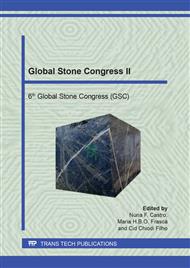p.3
p.10
p.20
p.28
p.35
p.48
p.58
p.66
Insertion of Silicon Carbide as Cutting Element in Ecological Fickerts for Dimension Stone Polishing
Abstract:
The dimension stone polishing consists of eliminating the surface roughness of the slabs with the use of fickerts. The main tools used for this activity are composed of epoxy resin, derived from petroleum, which contains chemical elements with harmful potential to the environment and human health. To overcome this problem, it is necessary to develop new technologies with the lowest environmental impact in the life cycle, from the raw material acquisition to the waste disposal. This study aims to contribute to the improvement of an ecological fickert developed by the Centre for Mineral Technology (CETEM). The fickerts presented here are composed of castor oil resin, silicon carbide and silica from rice hull ash. Two different compositional formulas were used for the preparation of the pieces that were tested in an industrial polishing machine. The results showed that the formula with higher percentage of fillers showed better performance, expressed by the relation between the loss of mass of the pieces and the increase of gloss on the surface of the slab. Other particularities of the product, as the high abrasion resistance of the matrix that reduced the cutting function, could be solved by choosing a filler with a lower hardness. This fact allows to infer that this line of research presents great potential of applicability in the dimension stones market.
Info:
Periodical:
Pages:
28-34
Citation:
Online since:
June 2020
Keywords:
Price:
Сopyright:
© 2020 Trans Tech Publications Ltd. All Rights Reserved
Share:
Citation:


